A bizarre intersection of drugs and religion in Longwa village, Nagaland.
The road to Longwa village began with a prayer and ended with opium.
Before our shared taxi left for the tribal village on the Burmese border, local heads bowed in unison. Hands clasped together as a young man said a prayer in Nagamese with closed eyes. The only word discernible to my foreign ears was “Jesu”, Jesus.
With a final “amen!” we set off on a bumpy mountain road that could certainly do with a divine blessing or two, driving past quintessential Nagaland landscapes: hilly rainforests engulfing bamboo villages, and deforested mountaintops dotted with woodcutter huts. Nagaland state, famous for headhunters, carnivorous diets, and a plethora of distinct tribes, is a wild place, and assuredly it looks the part.
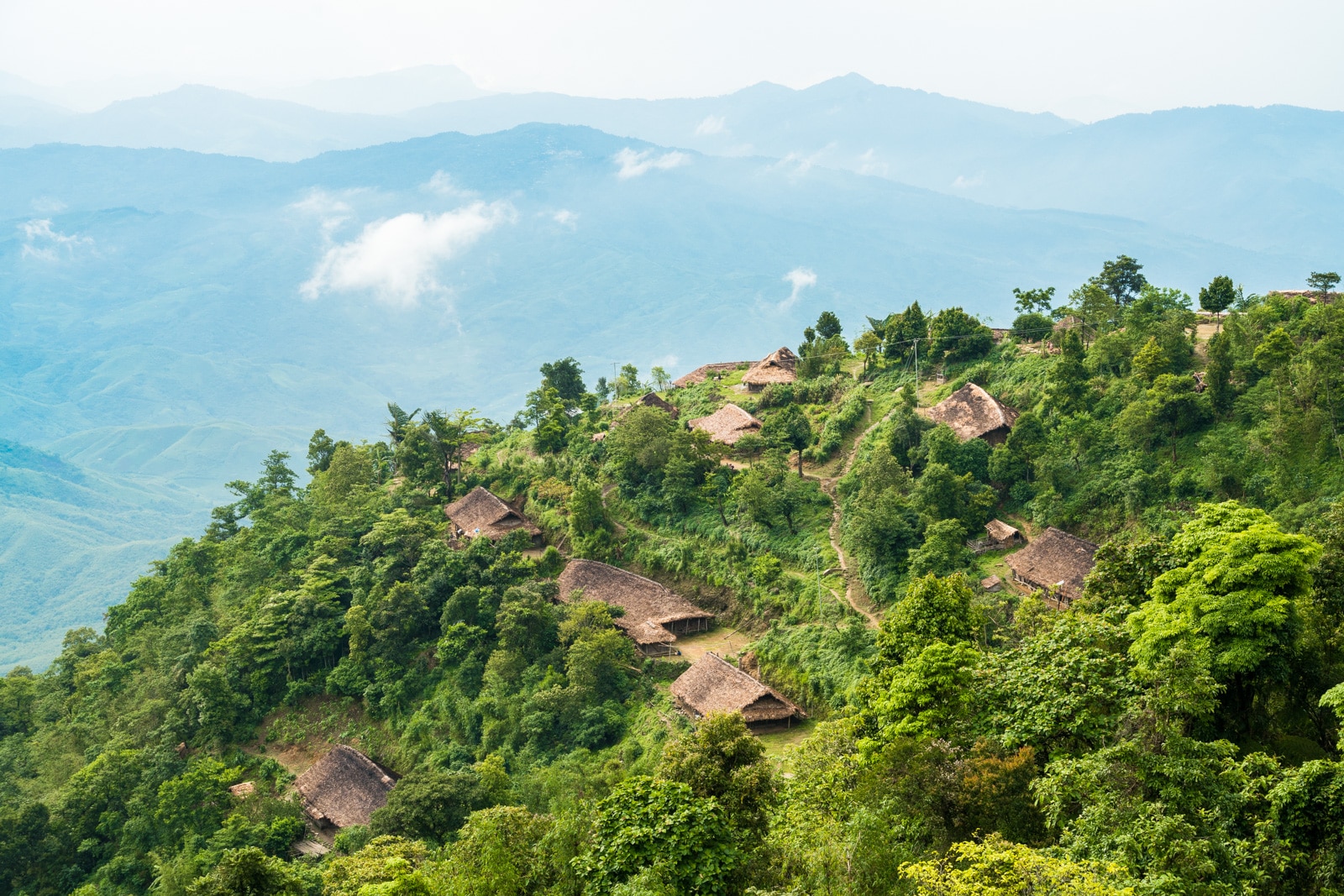
A tiny village on the Burmese border. We certainly weren’t expecting to travel to Myanmar on this trip, but life’s full of (technical) surprises.
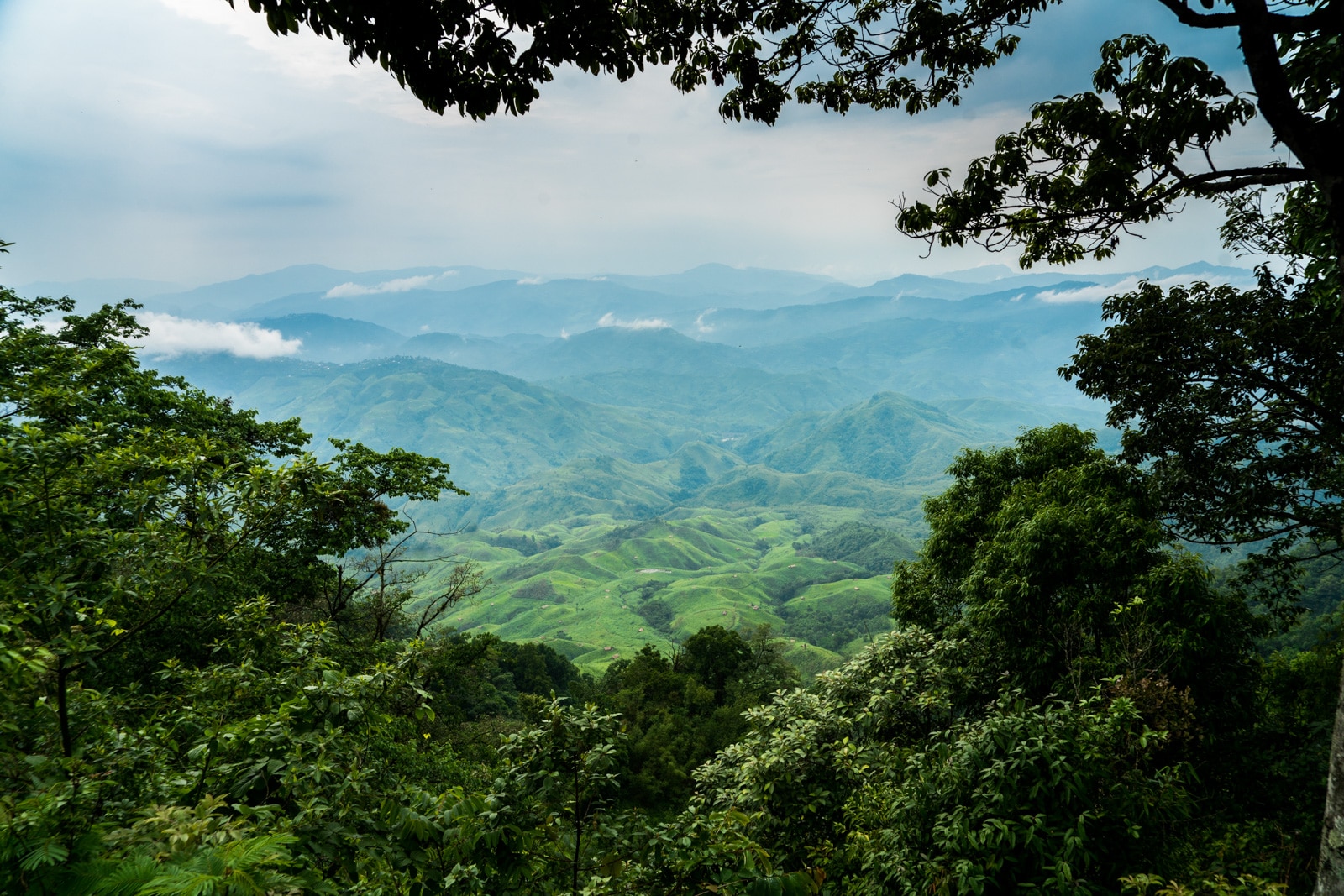
The slash and burned hills of Nagaland
After several bouncy hours, the car crunched to a stop in the center of Longwa village. As we extricated ourselves from the tangle of the shared Sumo vehicle, a cluster of local children stood silently by the roadside, waiting to guide us to our homestay.
Small hands gestured for us to follow, and we traipsed behind them down a slippery stone path through bamboo longhouses to our final destination: something that can only be described as an opium den.

Drug den in Longwa village
Countless skulls and weapons adorned the blackened walls of the bamboo longhouse. Mithun horns (a native sort of buffalo) pointed at clustered rows of wild boar skulls. Two ageing—but well cared for—rifles hung over yet more skulls, and decorative spears leaned against a wall plastered with yellowing photos of men in tribal attire.
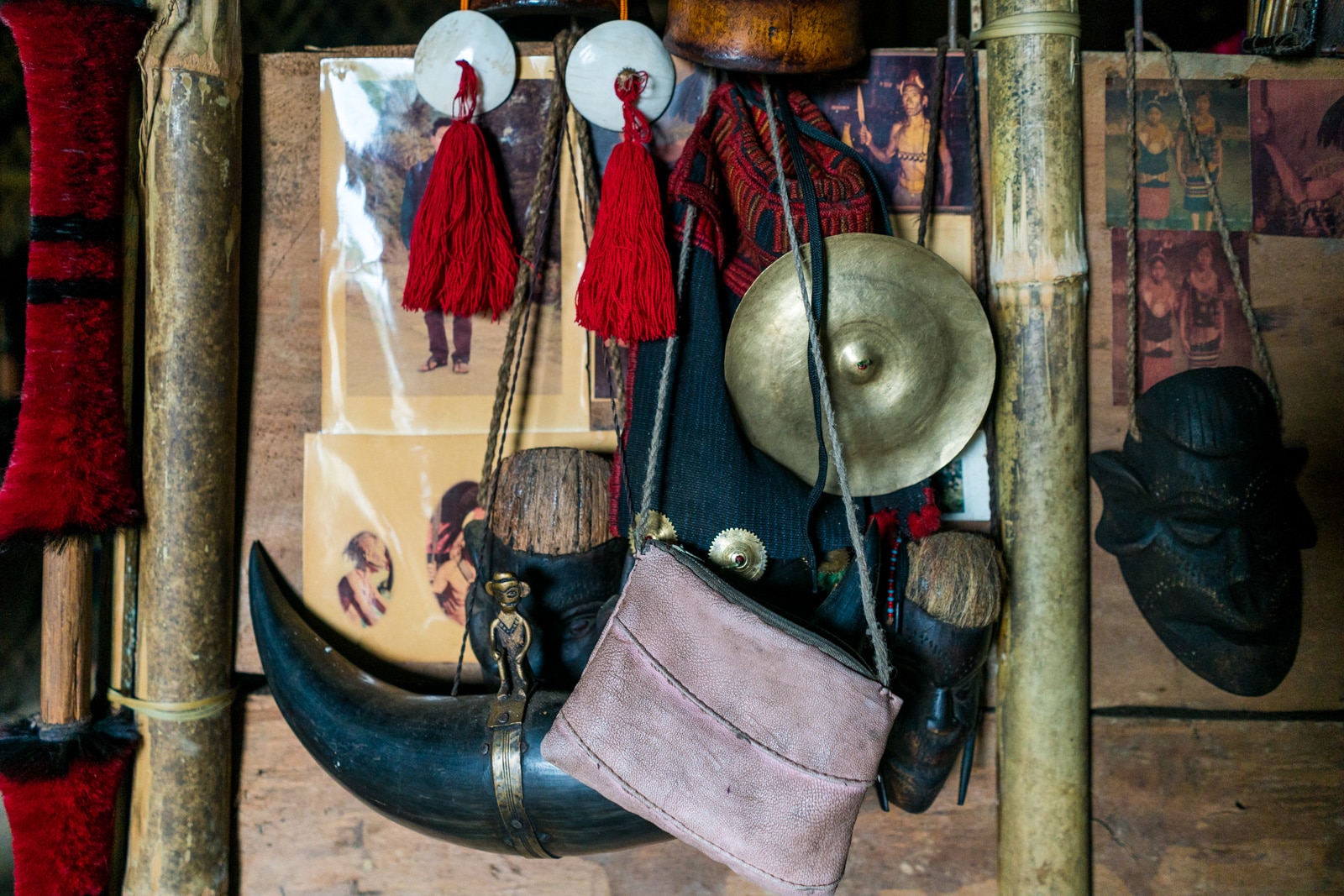
The spacious dirt floor of the longhouse was vacant, the true center of activity being in a corner of the house. A small, smoky fire burned there, encircled by four or five men sitting on their heels. It was hard to make their faces out in the dim lighting of the longhouse… and through the cloud of opium smoke floating around their heads.
We put our packs down and squatted on some small wooden stools, ogling our bizarre surroundings. Unfazed by our curious gazes, one of the men by the fire proffered us a loaded bong, followed by a halfhearted attempt to sell us some trinkets. The eyes of the other men remained fixated on spoons cooking in the fire, their bubbling contents far more interesting than two random foreign visitors.
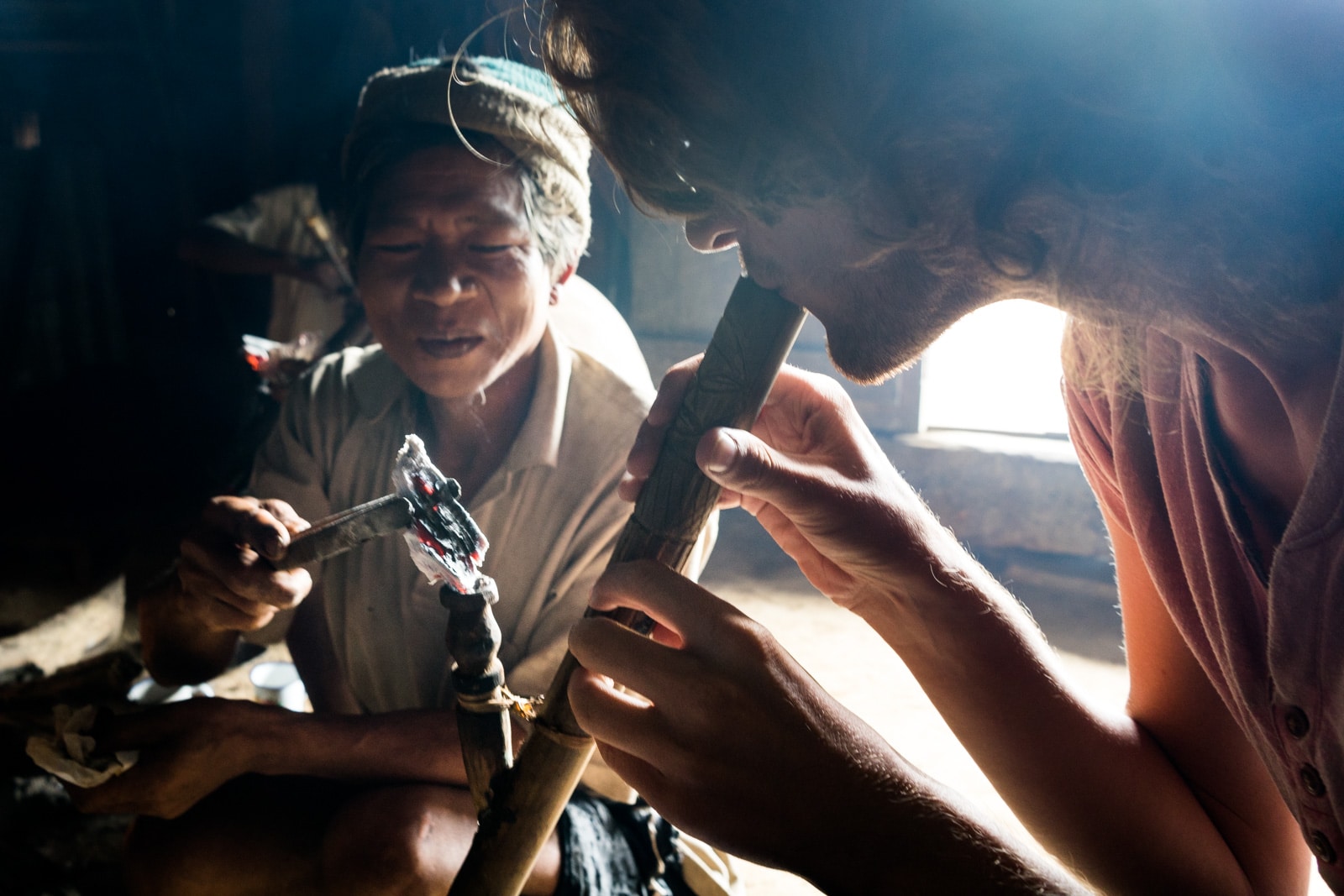
After a time, a wiry man ducked into the house, grinning at us with teeth stained rusty orange from years of opium and paan. He shook our hands warmly, shouting at his wife for tea before taking his own place by the fire.
This was our first encounter with Nyakto, our homestay host, and one of the most curious people we’ve met in our travels thus far.
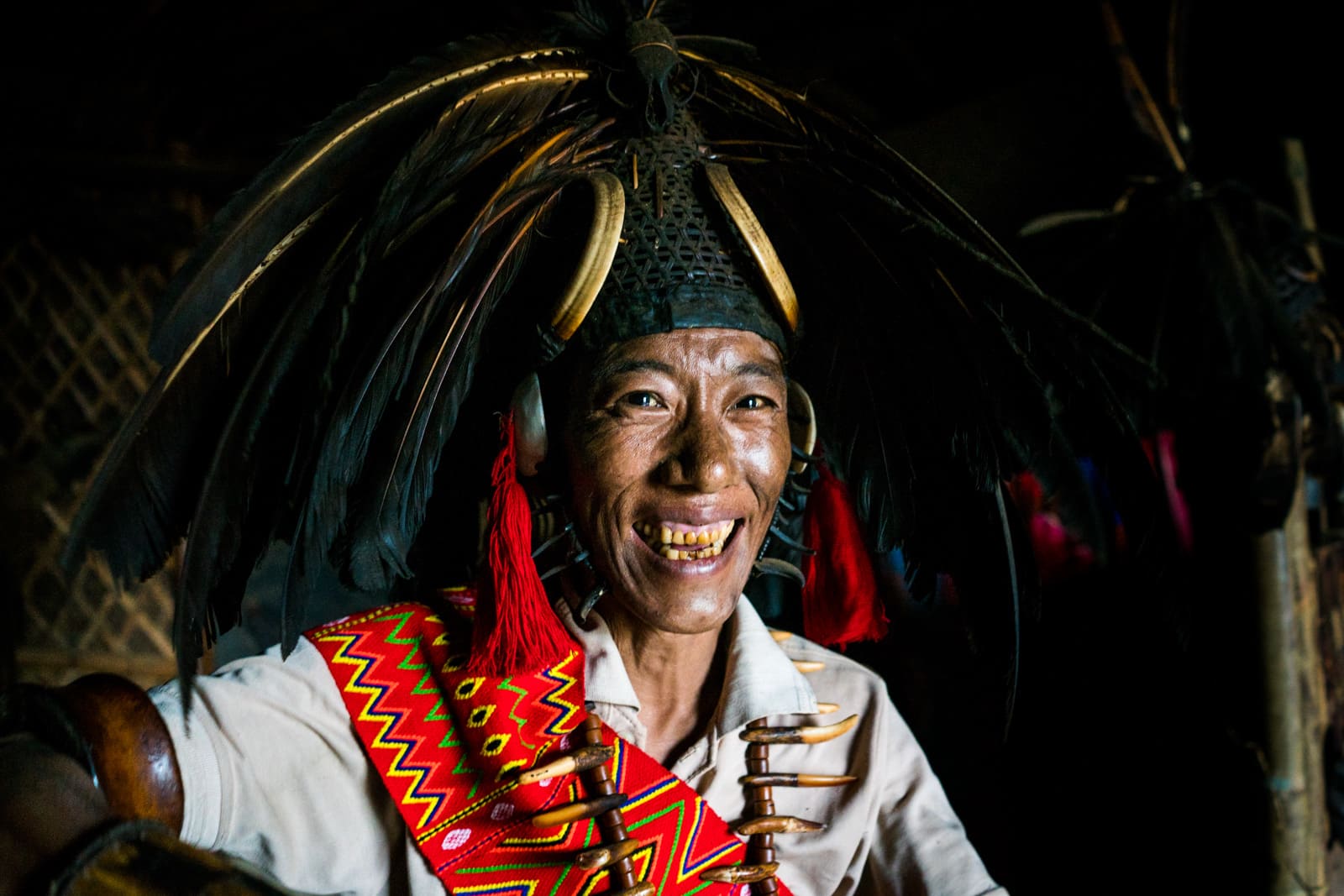
Getting all spiffed up in traditional warrior attire
Introducing Nyakto
Labeling Nyakto a junkie seems unjust… but it wouldn’t be inaccurate.
Every morning at 6 AM sharp, we found Nyakto sitting beside the fire pit, puffing away at his bamboo bong while cooking his next batch of opium. He smoked away throughout the day, and was often the last person to sleep each night. We could tell he was off to bed when his pink portable speakers stopped blasting tinny tunes, and his infectious giggling quieted down.
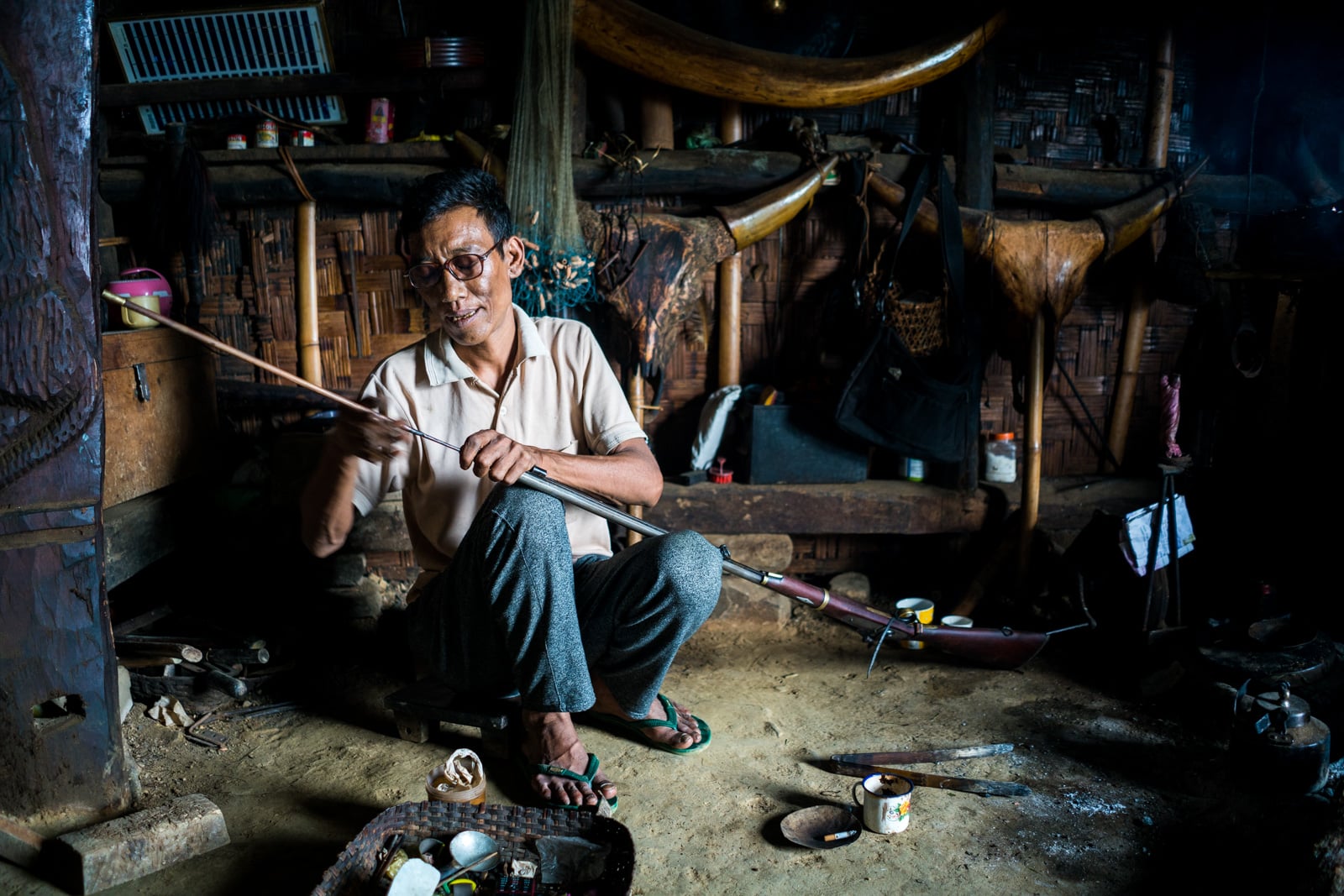
Casually cleaning out the ol’ single barrel
Nyakto rarely left his seat by the fire, except for the occasional household chore (ex. shouting at the pet pig), or to “go to Burma”, the code phrase for the one-hour walk to buy more opium from the country next door.
He was an addict defined, but curiously enough, he took a strong stance against other drugs. Smoking opiates all day was no problem, but he steered well clear of weed. When asked if he ever smoked marijuana, his eyes widened and his brow furrowed.
“Oh no, ganja is very bad. I smoke ganja, and my mind is cloudy and I go to sleep. No, ganja is dangerous.” He finalized his declaration with a puff of opium smoke, and returned to cooking his next hit.
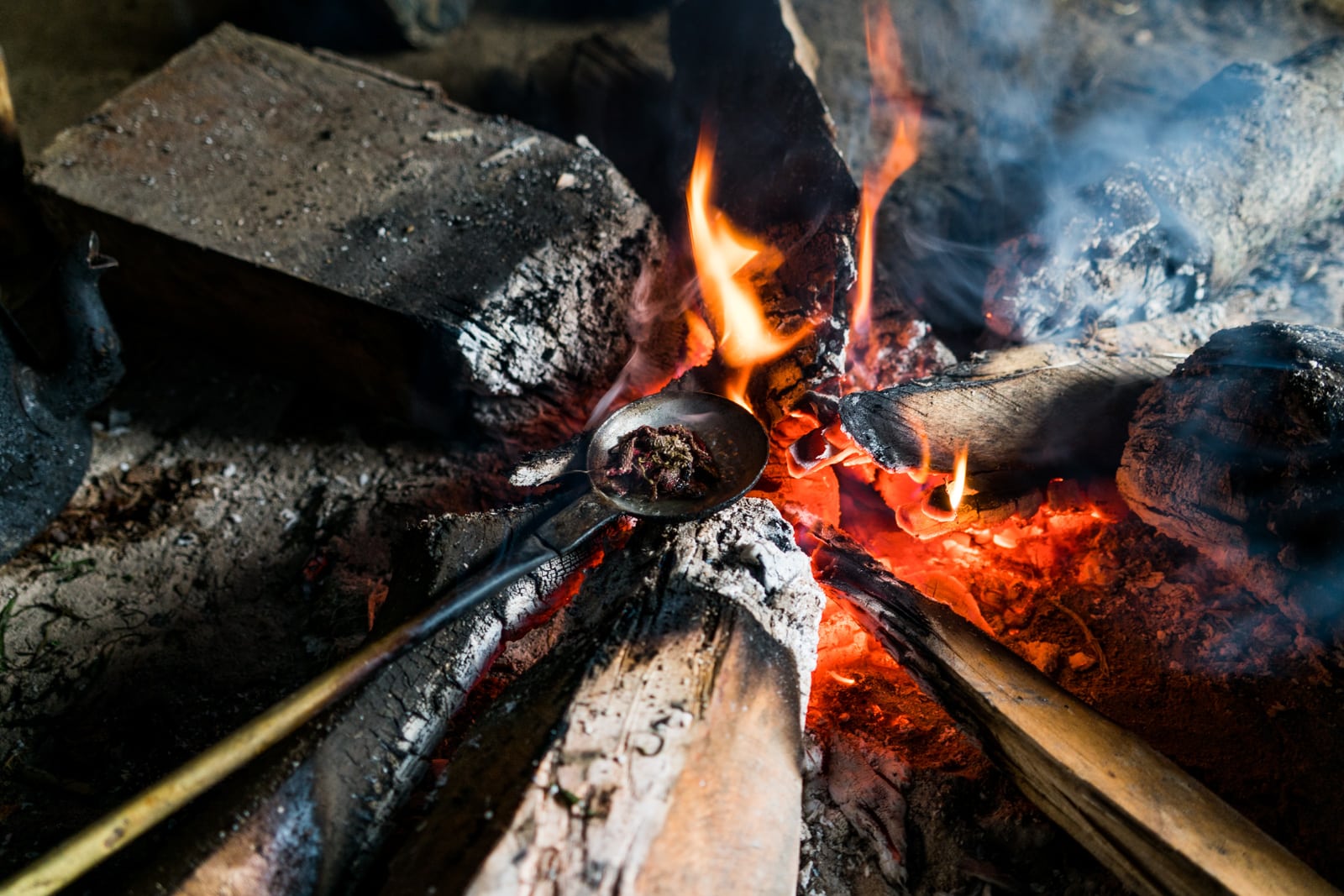
Despite the constant opioid haze, Nyakto was a perfectly chipper person. Though he never hunted any heads himself—that was his father’s field of expertise—he delighted in explaining Longwa culture and history, particularly if it involved dressing up in headhunter attire, waving a spear around, and shouting about all the people he (didn’t) kill.
[bscolumns class=”one_third one_third_first”]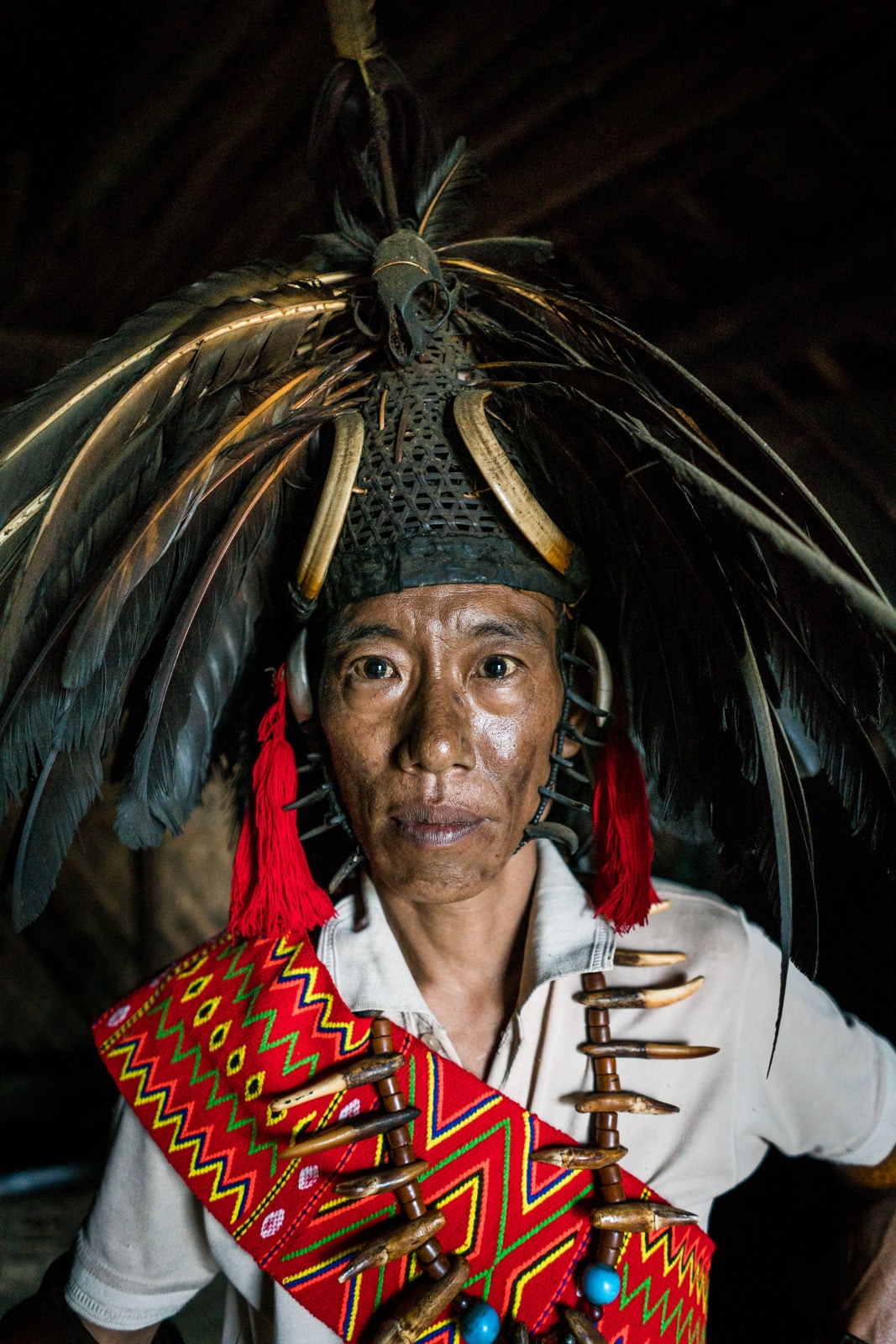
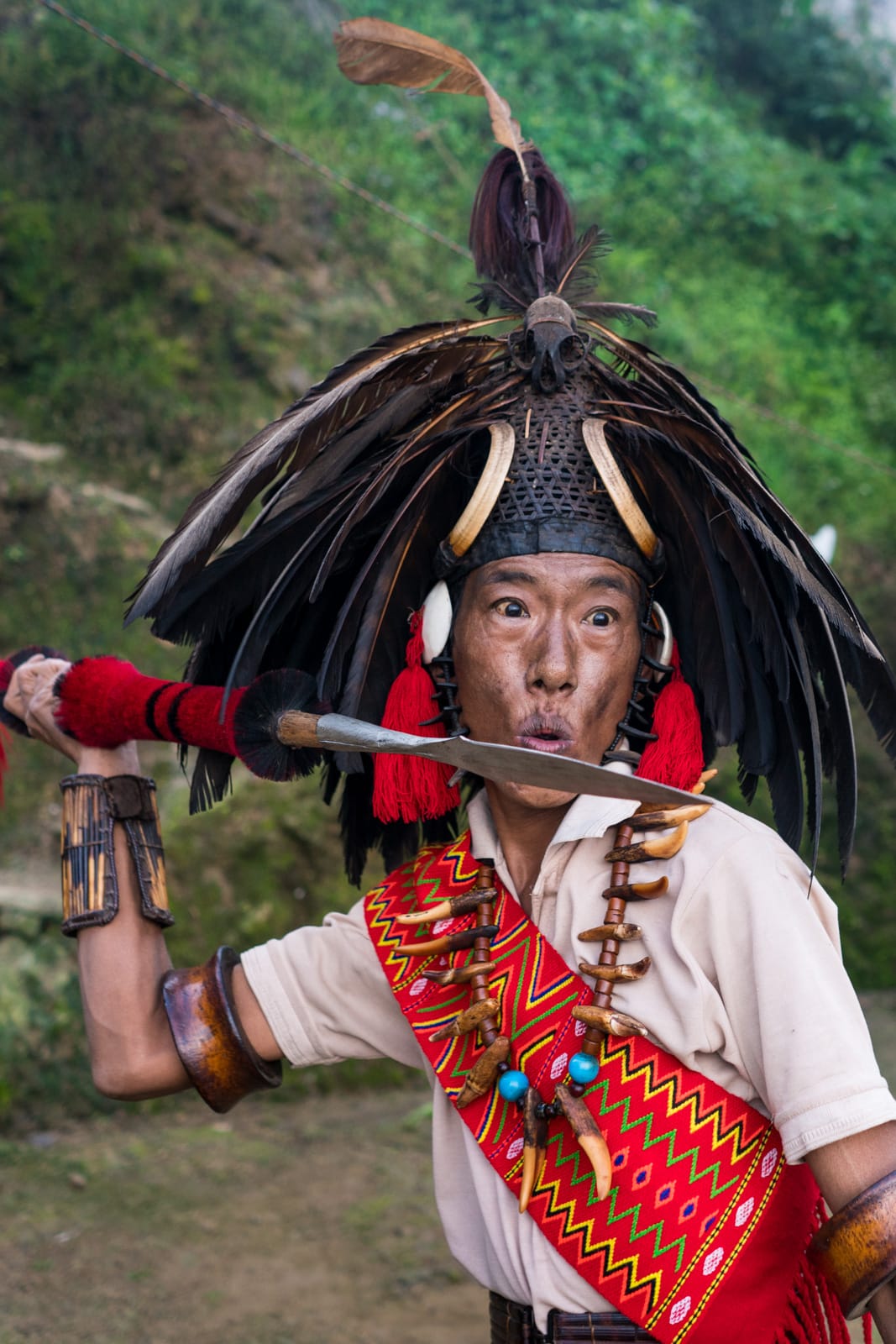
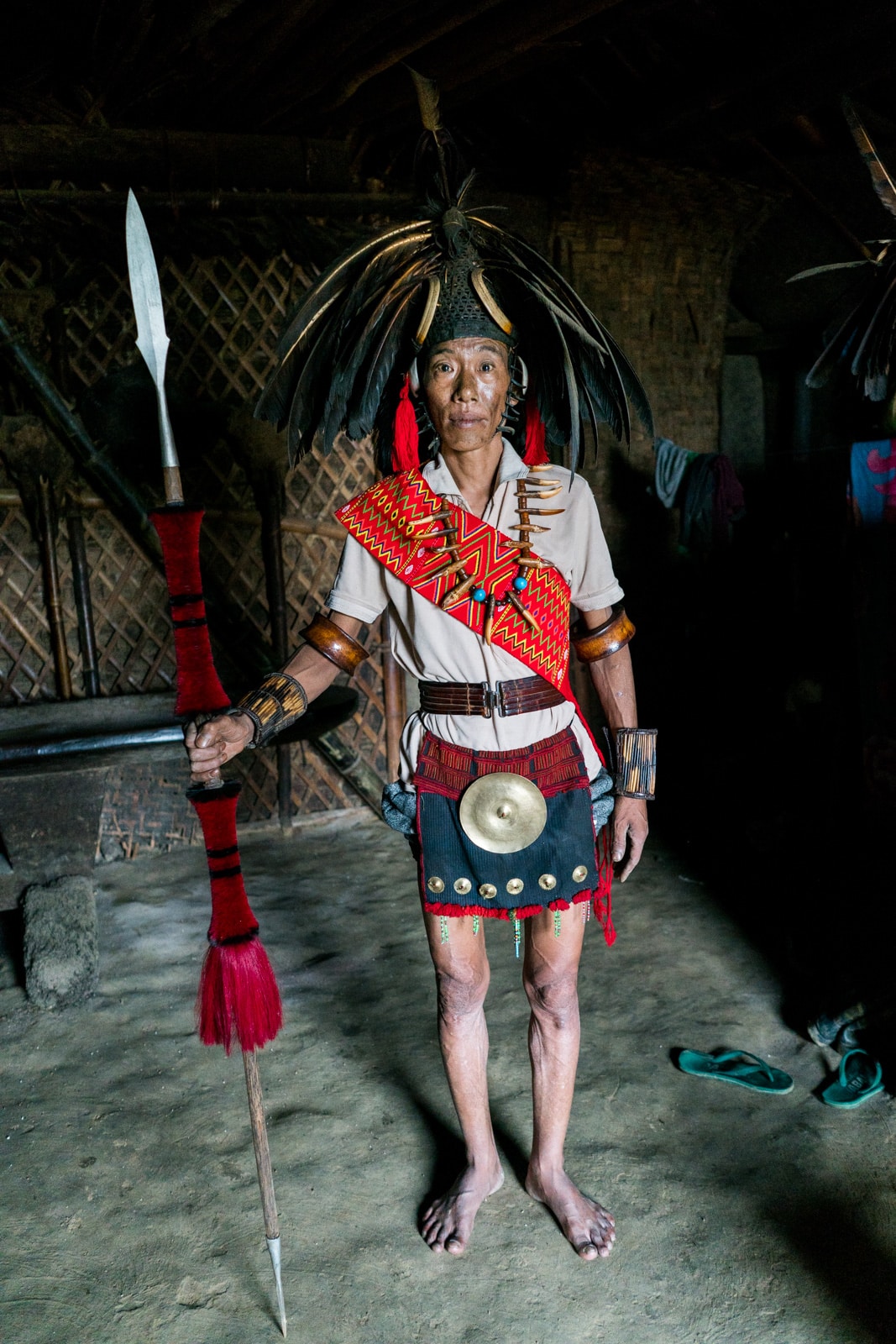
Aside from periodic warrior reenactments, he occasionally showed off designs for woodcarvings he’d been commissioned to make… though we only witnessed one hazy attempt to do so in the five days we were in his house. You can’t rush art, right?
It soon became clear, however, that Nyakto’s favorite pastime (aside from smoking) was singing about Jesus.
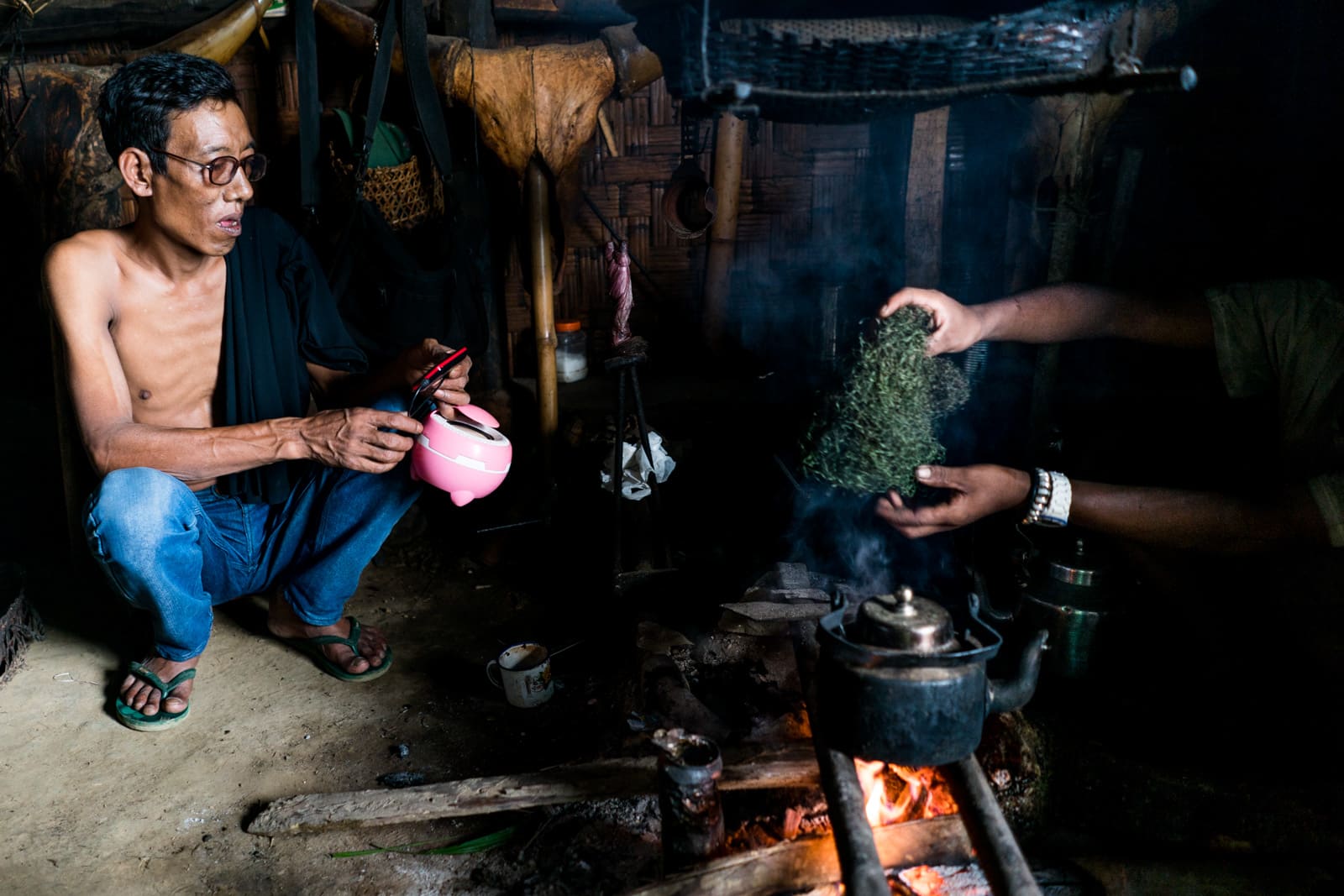
Mixing it up on the pink portable speakers
Jesus jams
A Christian music playlist, blasted through his pink portable speakers, served as the soundtrack to our village homestay. Ballads for Jesus blasted through the evenings. Lyrics about washing in the blood of the lamb cemented themselves in our ears and minds. Nyakto’s daughters had dance routines for several of the songs, performed with gusto as they softly sang their own interpretations of the English songs. Our only respite from the holy playlist was an out of place hip-hop song about drug money, which Nyakto usually skipped over with a tch! and a look of disdain.
Nyakto knew all the words to all of the songs, and was all too happy to show off his musical prowess. One more wholesome afternoon, he pulled out a church hymnbook translated into Nagamese, crowing blissfully as opium pipes bubbled in the background.
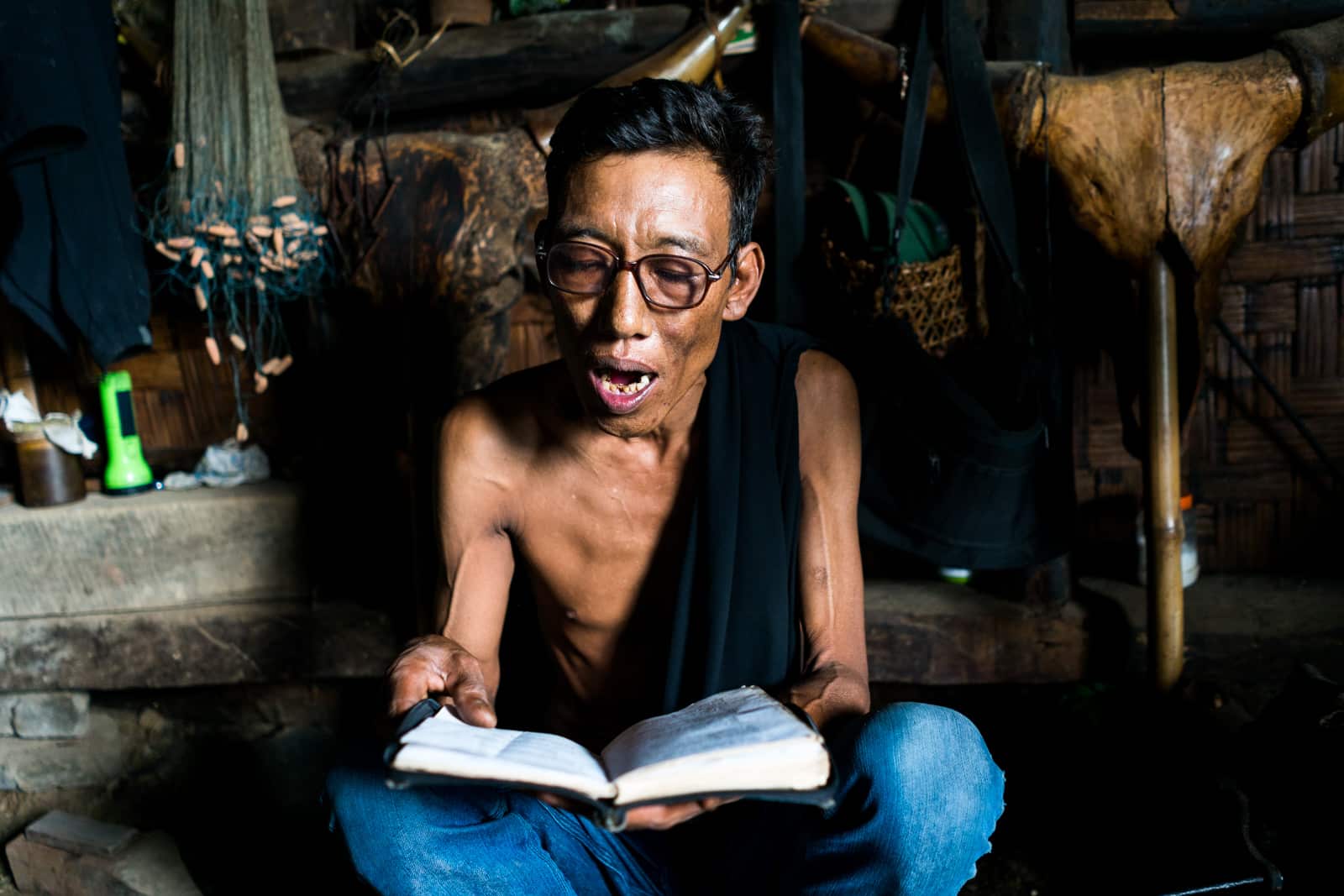
Drugs and Jesus seemed like an odd combination to find outside of a rehab clinic… until we learned that more than 90% of Nagaland’s rural population is Christian. And not the casual, only-celebrates-Christmas kind of Christian.
Naga youth blast Christian rock from their speakers. The most prominent buildings in Kohima, Nagaland’s capital, are all churches and cathedrals. Almost all schools are Christian schools. Men have flaming crosses tattooed on their biceps. Shops close and entire villages head off to church on Sundays. There’s more Christian fervor on the streets of Nagaland than there is in the Vatican.
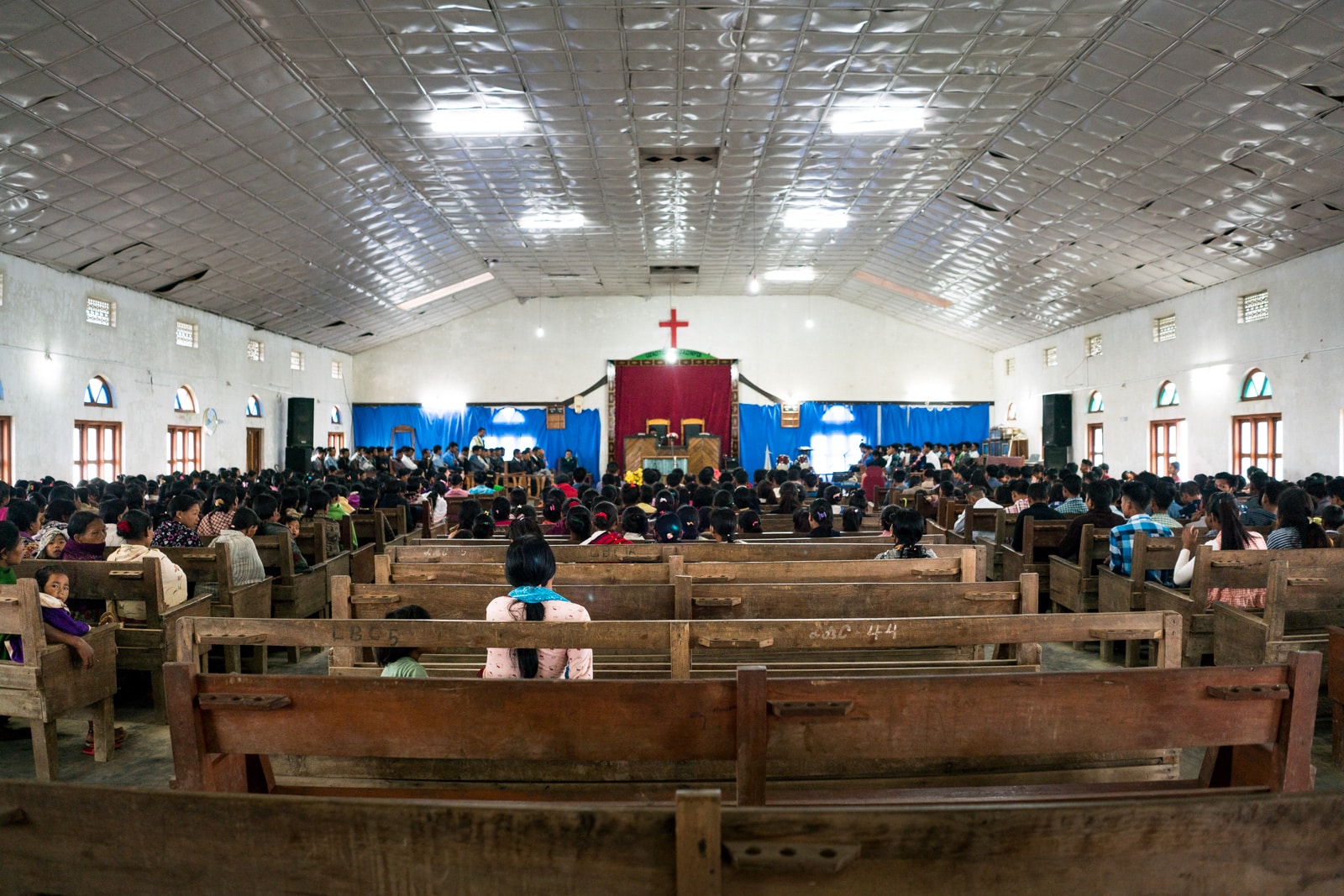
The place to be come Sunday morning
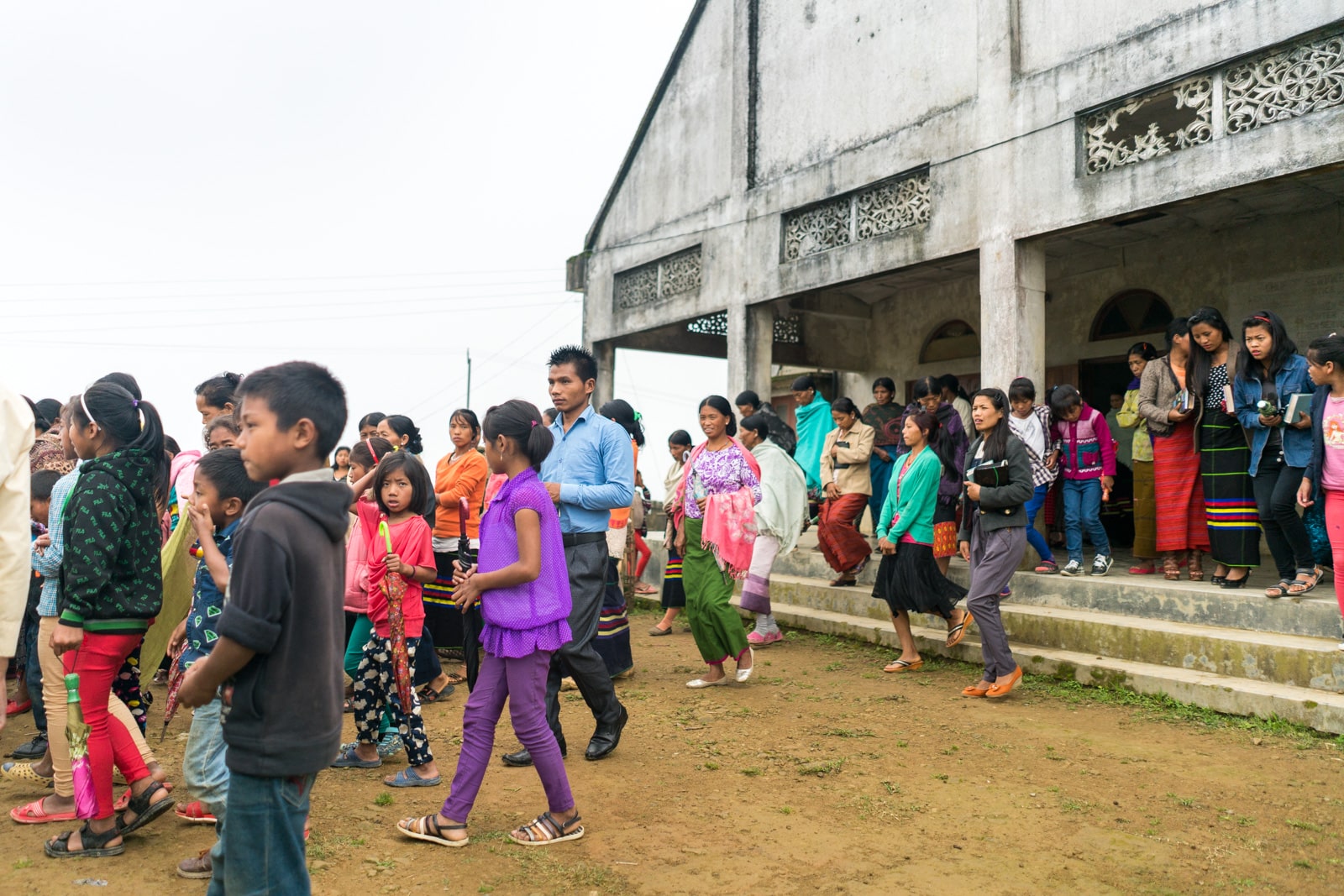
Be there or be square
As for the drugs, that’s an ailment specific to the Naga tribes living along the Burmese border. Opium, produced in Burma (Myanmar), flows relatively freely across the border, and has become a popular killer of time for the men of Longwa and the surrounding villages. Opium use was common more than a century ago, but then died out for a period of time. Addiction levels are back on the rise, however, thanks to Burma increasing its drug exports and the virtually nonexistent border between India and Burma in the region.
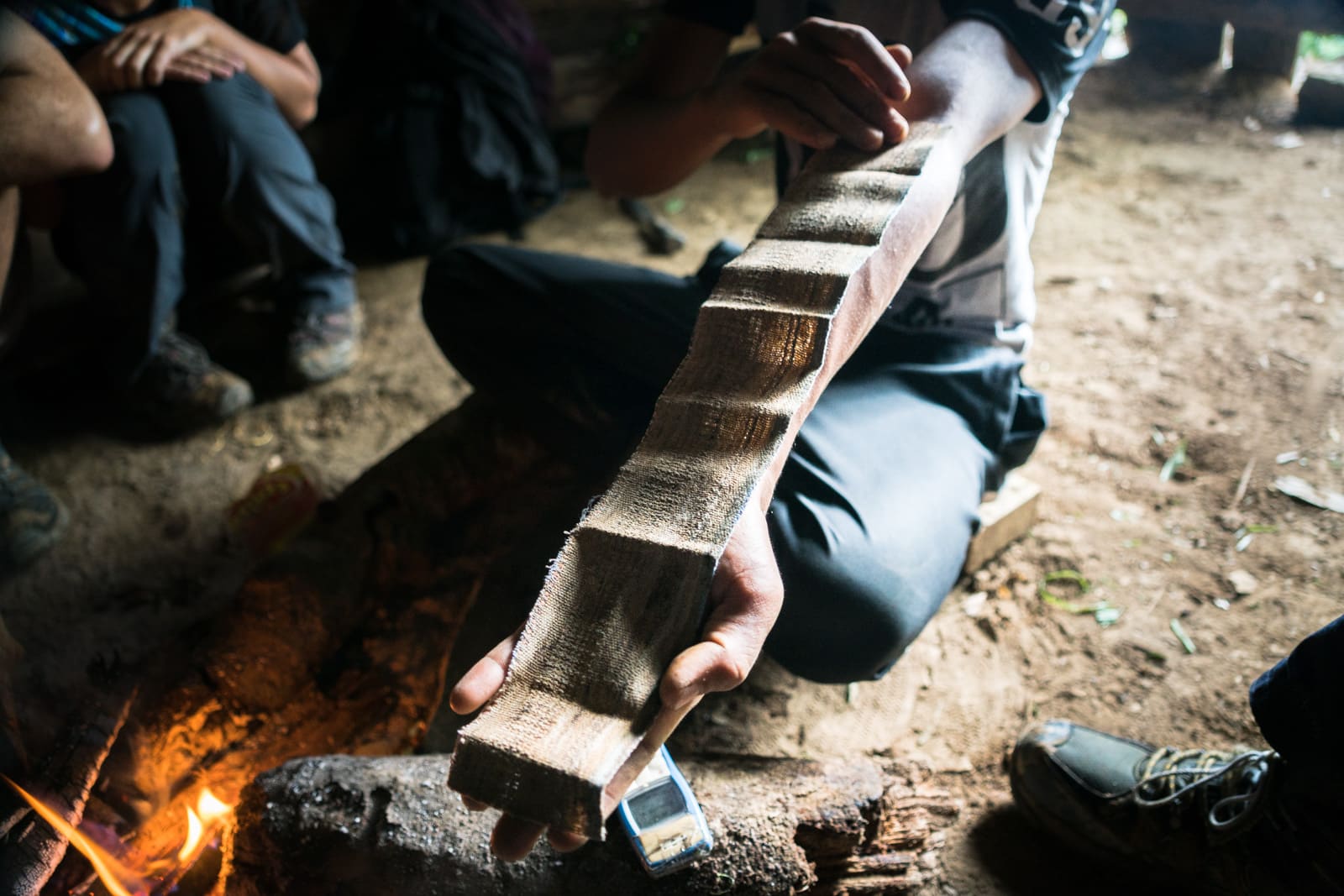
The men of Longwa use arm lengths as a metric for opium
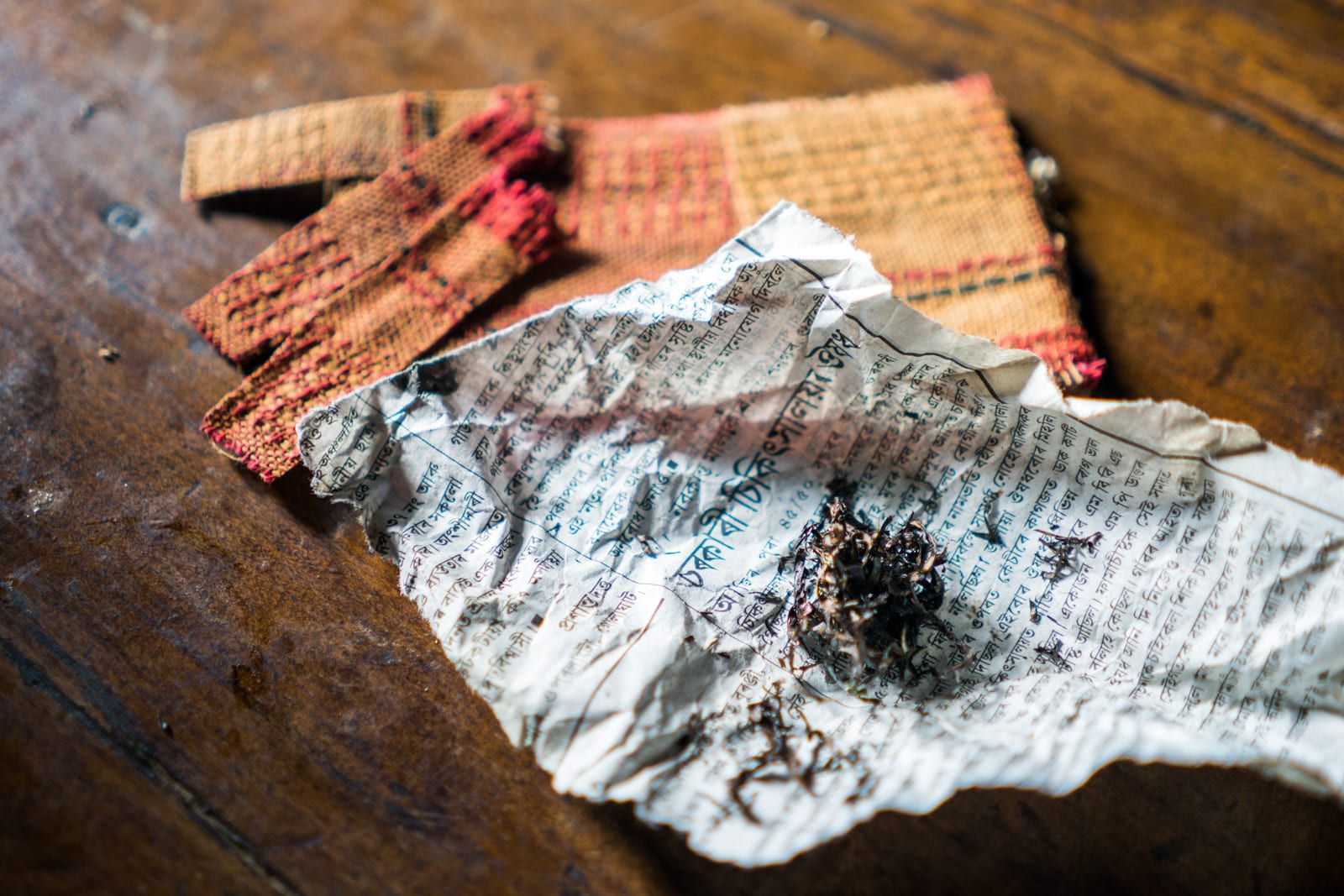
Prepped and ready for smoking
The church is obviously against the use of drugs, but it takes a strong person to resist addictive—and plentiful—opiates in a village with little else in the form of entertainment. The men we spoke to were more concerned with women harassing them about smoking than their habit upsetting the Lord above.
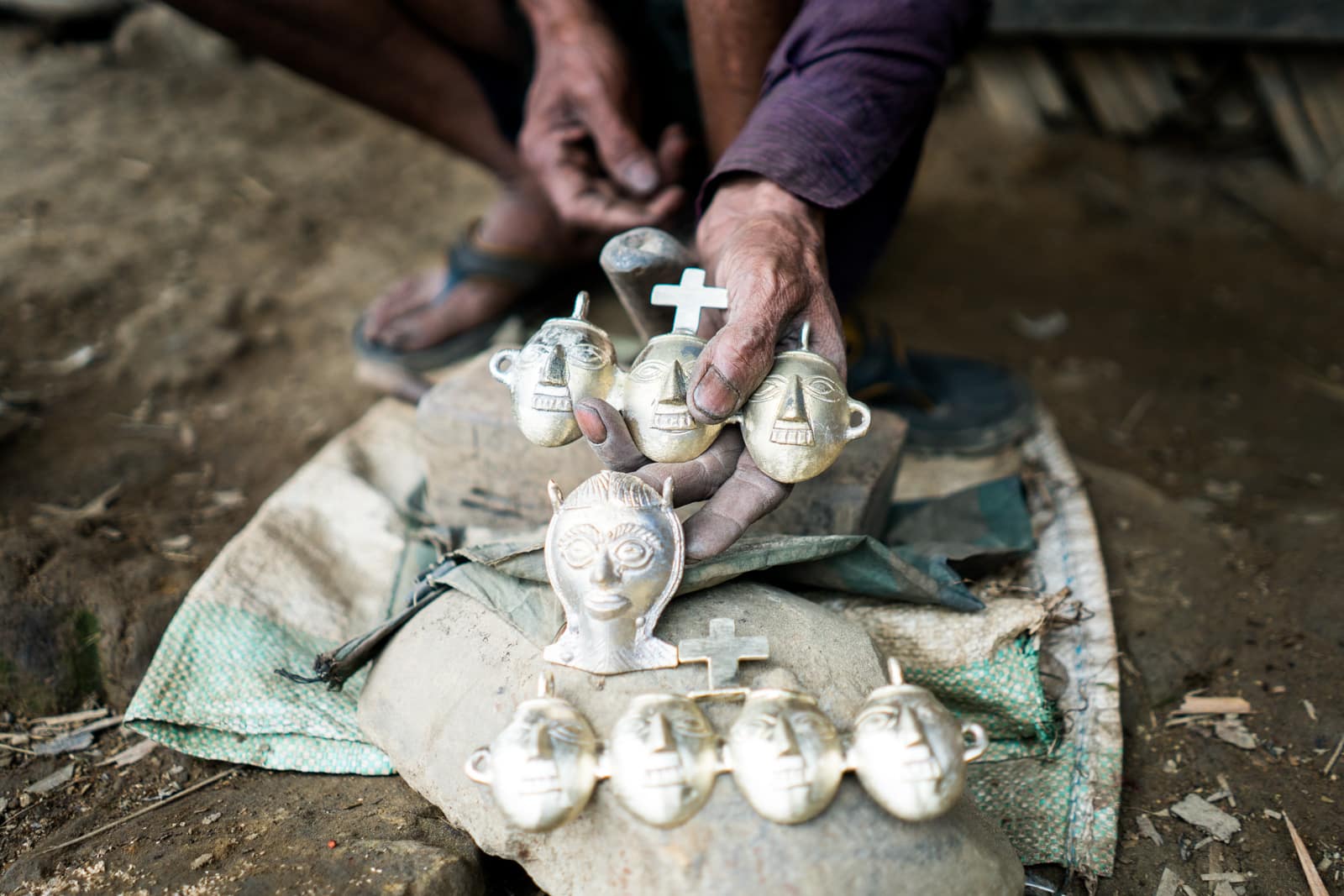
Headhunter bling meets Christianity
From hunting heads to praying before bed
Given the lack of things to do Longwa other than smoke opium and ponder life—especially during monsoon rains—we whiled away many an hour discussing the bizarre intersection of Christianity and headhunter culture in Longwa and Nagaland. For real, though… how the heck did a bunch of tribal headhunting warrior people transform into devout churchgoers (with a drug addiction)?
Asking Nyakto never revealed much of anything, and the same held when Nyakto’s father, Yaowang, ex-headhunter extraordinaire, was questioned. Both gave the same answer: Nagas are now Christian because Jesus is their savior, and Christians don’t hunt heads. Or kill anyone in general, for that matter.
Duh?
We had to dig deeper, and eventually found some answers buried in a dry tome in Kohima about the history of Christianity in Nagaland:
Before the Naga people joined the Christian flock, they worshipped the sun and the moon, and collecting heads was a source of pride. Tribal disputes would be settled by sending the village’s best warriors to fight each other. The winning warrior settled the dispute—and got to take the loser’s head as a prize.
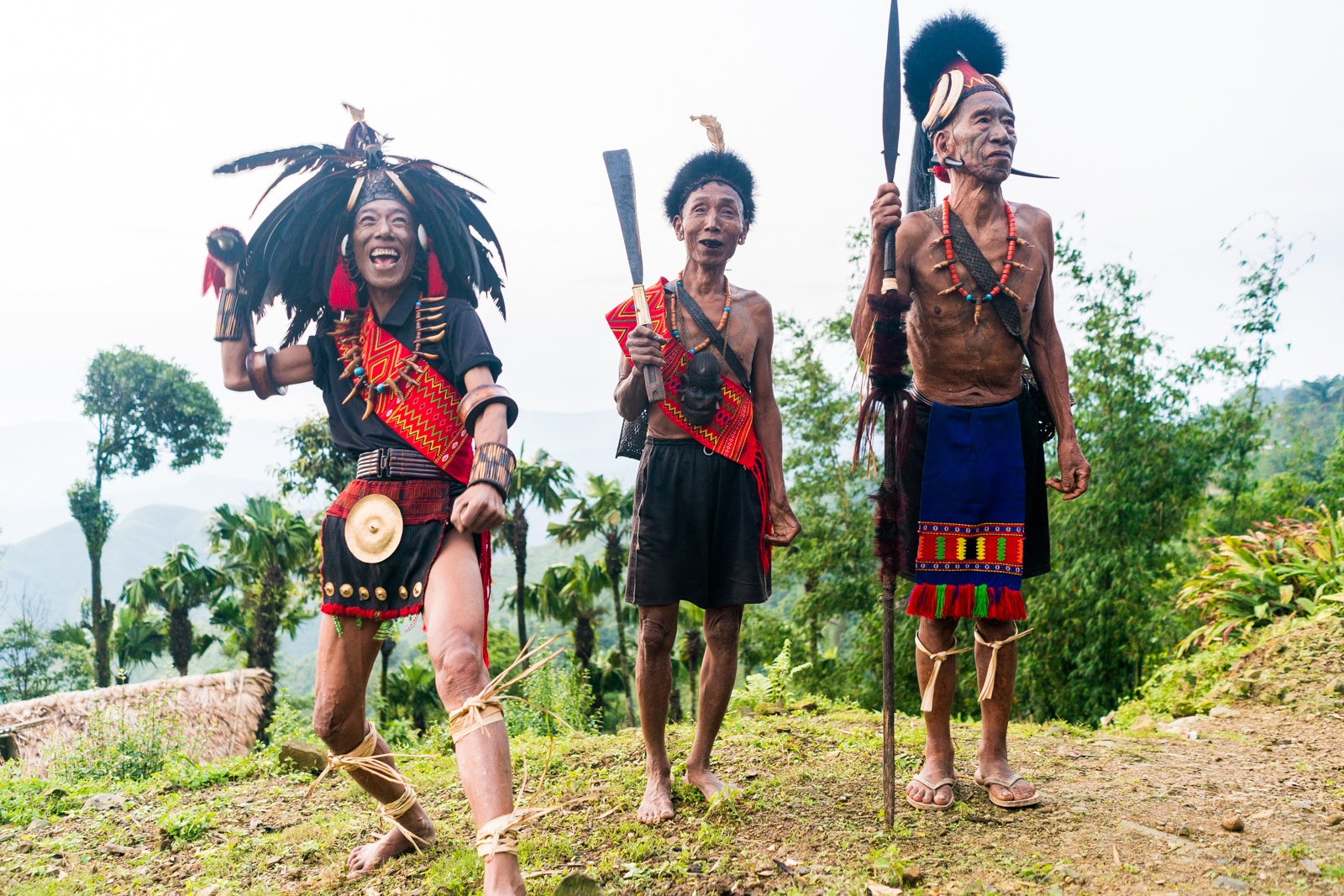
Warriors, attention!
But the culture began to wane in the late 1800s, as American missionaries penetrated the Naga hills. The missionaries, protected by British forces, set up schools and medical facilities throughout the region. Naga people passing through towns to trade saw what the missionaries were doing and how they were living. The Nagas were no fools—they realized education was key to success and wealth, and if their education had a Christian flavor to it, such was the price they had to pay.
One century and a lot of Lord later, there are schools all throughout the state, many people have a good command of English, and everyone is Christian as can be. Mission accomplished?
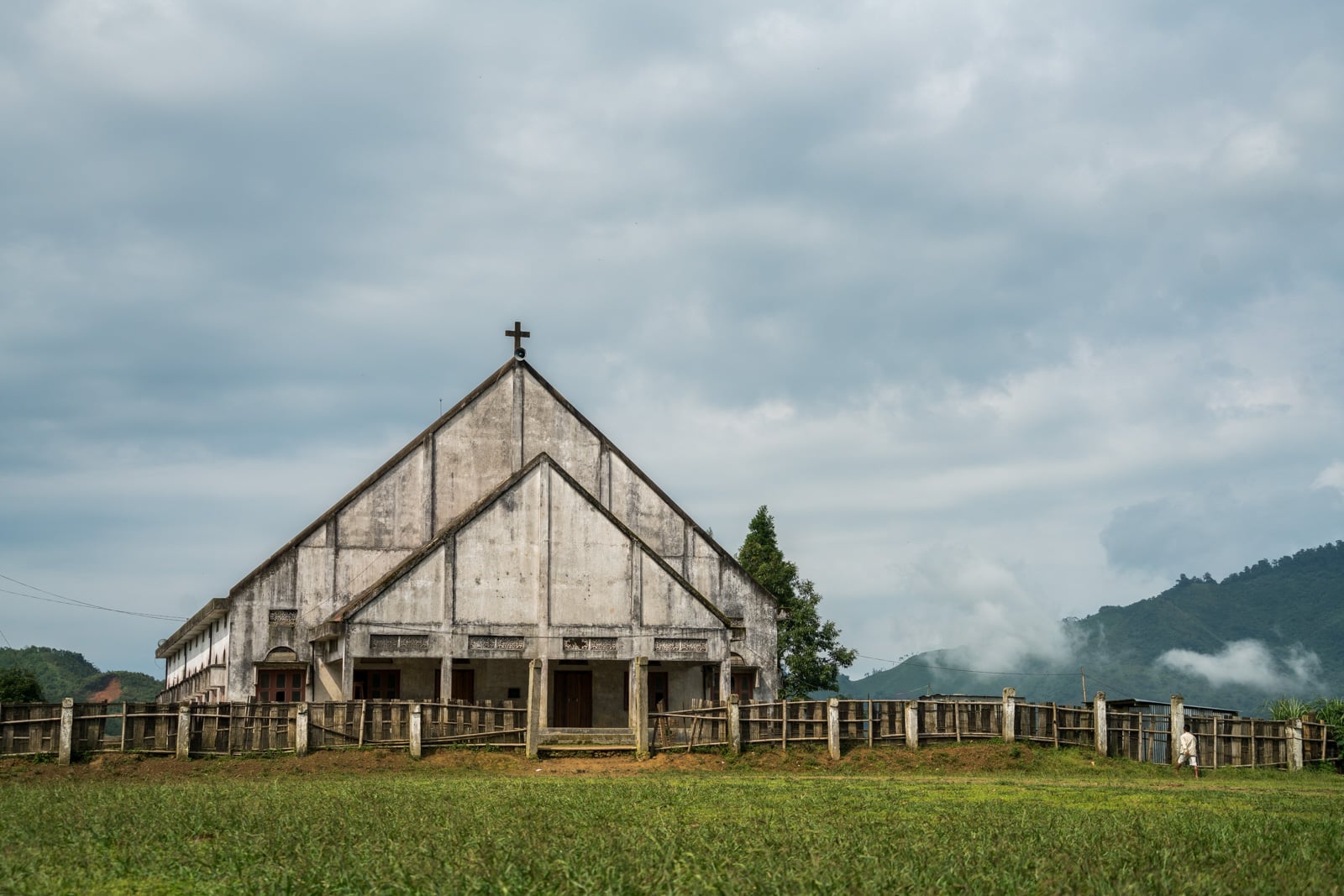
The local Longwa church
Keep your heads down
It’s a classic tale of missionary work, and, like many of its kind, it’s bittersweet.
Back in the day, headhunters proudly displayed heads they’d collected, believing the skulls to have useful magic properties. But, since Jesus came to town, the practice has vanished. Headhunters were strongly encouraged to bury their heads, and some of their culture was buried with them.
We joined a fellow tourist one afternoon as he enquired about seeing the hiding place of one headhunter’s collection. The tourist emerged from the man’s house, across the lane from the local church, shaking his head. The headhunter was afraid to show us the burial spot, for fear that the church would find out… and shame him.
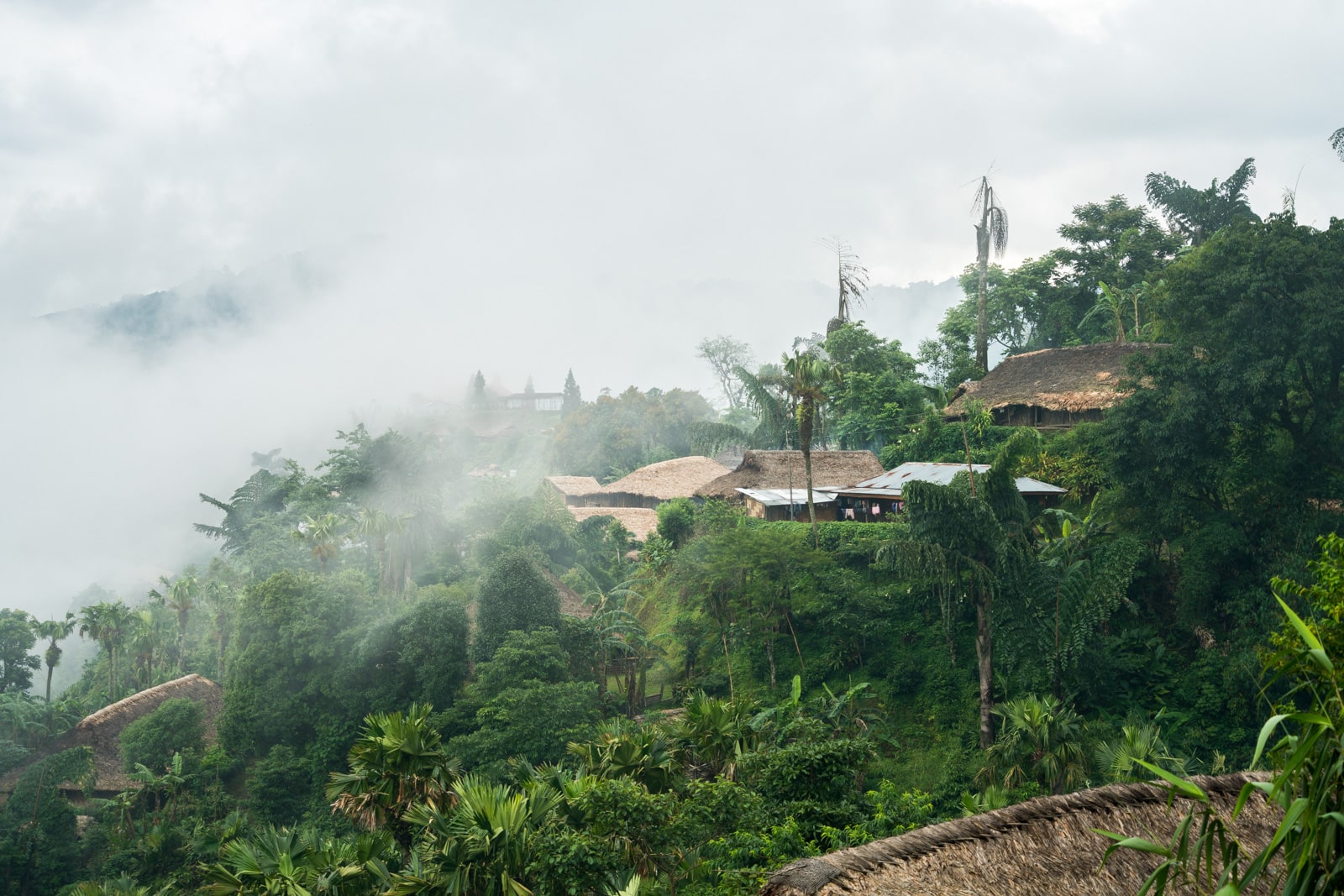
Longwa lost in the clouds
An end to bloodshed
To be fair, not all of the Christian influence has been negative.
Religious or secular, no one can argue against the benefits of education, and the positive points don’t end there. The gradual conversion to Christianity brought peace to an otherwise turbulent region. Before the missionaries came, there was a long history of violence and animosity between the different tribes of Nagaland, Longwa included.
“Before Christianity, no one visits other villages, and visitors can not come to us,” Nyakto told us one afternoon while stoking the fire. A friend of his from Longchan village had just stopped by to sit and have a smoke.
“If they visit, they are killed. But now, we are Christian. Christians love their neighbors, and now there is peace in the villages. We can visit each other, there is no more fighting.”
Nyakto translated for his friend, and the visitor nodded solemnly in agreement, exhaling a cloud of smoke.
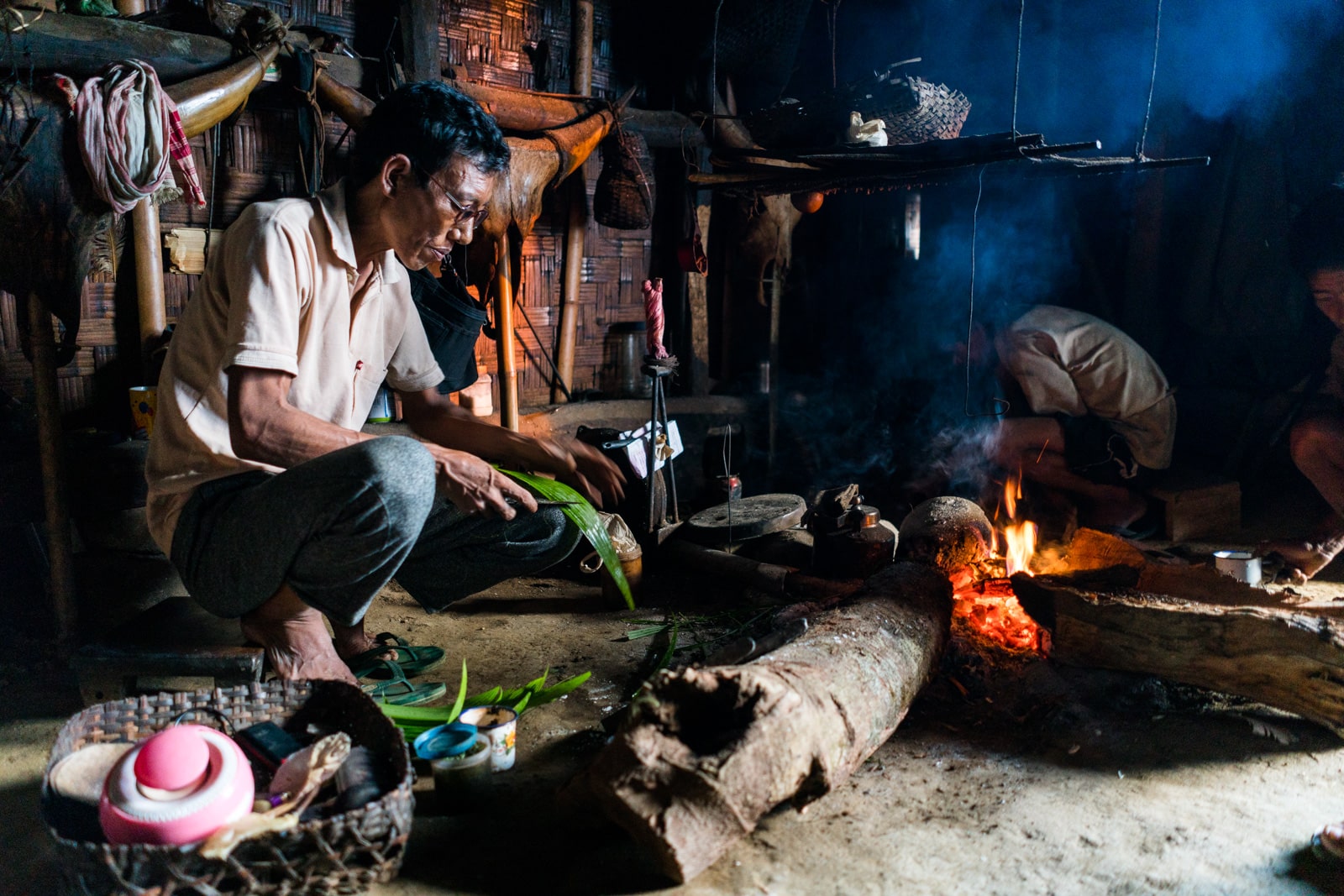
Perpetually prepping
As time progresses and generations age, Nagaland’s tribal culture and history is fading out, and Christianity is moving in. A ceasefire between tribes can only be good, but is peace worth the change culture? Perhaps.
But it doesn’t matter what you or I think—it’s up to the Naga people.
Where to stay in Longwa village, Nagaland
If you’re interested in immersing yourself in the oddity of Longwa, Nyakto’s homestay is open to visitors.
The accommodation is extremely basic—just a bamboo hut with a wooden board bed and a dirt floor. He charges 800 Rs per double “room”, including breakfast, a snack, and dinner for everyone. It’s expensive, and it’s partially funding his drug habit, but that’s an issue you’ll encounter anywhere in the village. Never fear, he does spend money on his family, too.
You can either try calling him at +918131903195, or have the infamous Aunty from Mon call ahead to arrange things. Aunty runs all the guesthouses in Mon and has her own homestay (Google Maps link) so you won’t have trouble finding her/someone handy to help you out.
Tours to tribal villages in Nagaland
If you don’t feel like going through the hassle of organizing everything yourself, we recommend Greener Pastures. They’re a tour company based in Northeast India with lots of experience traveling through the region, and they offer tours of tribal villages all throughout Nagaland.

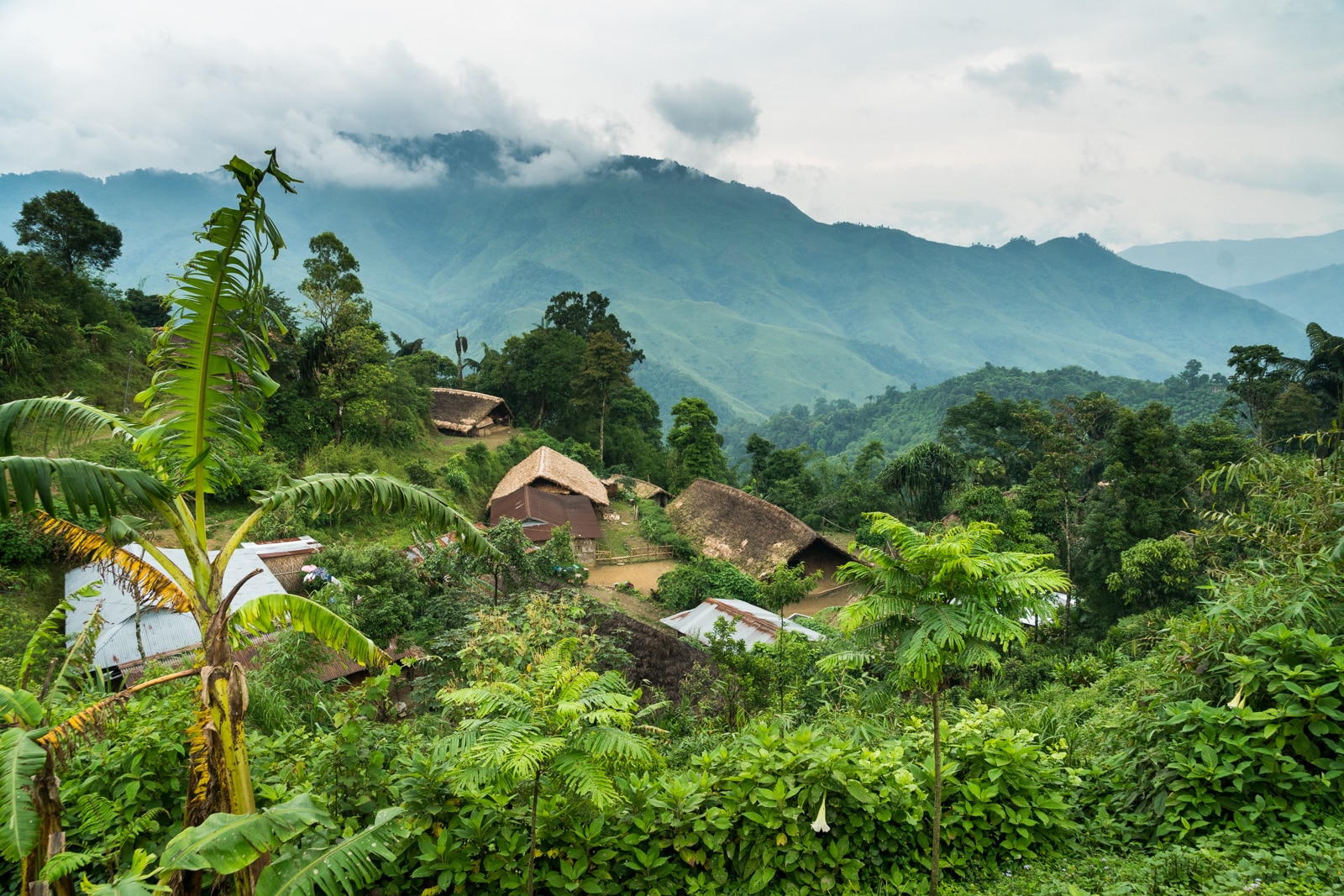


Loved the piece, Alex. Fresh and unique. Have you considered submitting your writing to a publication like Roads & Kingdoms? It would make me very happy if more people knew about your work!
Interesting, I never knew about that site! I’m checking it out now… and I totally blame you for the 2013890 tabs of articles to read that now sit open on my computer.
(Thanks for the heads up 😉 )
What an experience… I can only imagine what it must have been like… Christian rock and opium – what a combination o___o
Interesting how Christianity (or any other religion) gets mixed with the local culture for these surprising outcomes… I’m constantly bewildered with things like this in Pakistan too.
It’s bewildering, but pretty damn cool, too! Adding a bit of local flavor makes things much more palatable for everyone 😉
What an interesting story! I had no idea such a place existed, which is exactly what the best travel writing does – makes you aware of previously unknown cultures. If you have any interest, we would love to have you write a piece or two for our blog.
That’s our blog’s goal—to show people there’s more places to travel to than the standard Eurotrip or Southeast Asian adventure 🙂 I’ll give your blog a look, but I’ve removed the link as we don’t allow irrelevant links in the comments.
Love stories from the road like this, absolutely fascinating! Thanks for sharing and including such poignant photographs as well.
Glad to hear that! Good to know people actually like our writing 😉
Brilliant article and so interesting to read!! I love discovering and reading about lesser-known cultures like this one! Wow! How was the opium????? and how did you find out about this guy and his tribe?
Glad you liked it. We were really high, but honestly, it’s not a drug either of us would want to use often. There’s a big disconnect between body and mind, which made it a bit weird. Our minds were really clear, but our bodies just wouldn’t listen 😉
So this guy runs a homestay, and we were given his number by another homestay owner. People in the region just sort of know each other, so it was much easier to connect than you would expect.
Phenomenal photography here. You almost make me get up and leave my job to hit. Sigh. Someday. Thanks for being my eyes while I’m stuck behind my desk.
I meant that to say, “to hit the road.”
Thanks for the compliment, it really means a lot to us 🙂
“To be fair, not all of the Christian influence has been negative.”
Sounds to me like it has all been positive. Where does the negative aspect come into play here? By the fact that a culture is fading away? What of the fact that this culture came to exist in the first place because of people enacting violence out of fear of being overcome by the strangers next door?
This type of culture no longer persevering in these villages should be celebrated. Instead, it’s all too common for tourists who want to snap a few photos of some dug-up decapitated heads of husbands, fathers, and sons to rue the loss of this experience.
Eventually, if opium addiction is curbed/eliminated in this village, will that also be a sad loss of culture? Or, rather, would it be a triumph? I thought the answer would be obvious… but this post, along with these comments, make me wonder.
Assertion of one’s own culture, ethics, morals, and belief system onto another is never a good thing. Just because you think your way is better, doesn’t mean you should shove it down others’ throats. That’s essentially what happened in Longwa and any other places proselytized by missionaries. These positive gains could have been realized without
brainwashingproselytizing an entire group of people and attempting to erase their history and culture to the point that they are now afraid to talk about it.Did the Longwa willingly accept Christianity, or were they forced to?
Your claims are only valid if they were forced to adopt Christian beliefs.
Receiving and education was linked to converting, and all education was given with solidifying conversion in mind. So although they weren’t forced at gun point (that wouldn’t be really Christian) they were certainly cajoled into converting. And from what we gathered from the historical account of Christianity’s rise in the region, the missionaries we’re quite assertive when it came to their task.
Hmm… that’s interesting.
First off, I have some pretty strong ideas for how Christianity should be shared with people. Or, for that matter, any religion, but for the sake of this discussion I’d like to stick with Christianity; not only is it directly applicable to this situation but modern-day Christians seem to focus on giving exposure/converting people more than other religions do. I have no numbers to back that claim up so maybe I’m wrong.
Anyways, it’s always funny to me how some Christian missionaries seem to want to convert a people group at any cost, including through coercion, fear, etc. Maybe that happened here, maybe it didn’t. You will have a better idea of that than me.
But regardless of the methods that were used to convert people in this region, you cannot deny that people are no longer killing each other between villages. No longer do the people that live here need to worry about the very violence that you wrote about yourself on this post.
Why is that a bad thing? I mean, we are referring to this culture as “head hunter culture!” If I were a Longwa villager, I would be happy to see my own culture die out if it was based on constantly living in fear of my neighbors. I imagine it being like a season from The Walking Dead.
I do agree that the history of a people should be preserved, and it is a shame that artifacts/dead people’s heads have been buried and cannot be excavated out of fear of prosecution from other villagers… but is it possible that this insistence to keep these artifacts buried may come from the fear of the way things used to be? This is all conjecture, but it is absolutely a possibility.
I left my country seven years ago and have been living internationally since then. During this time, I have become increasingly frustrated with the mentality that people tend to exhibit when cultures are altered.
Cultural diffusion is something that happens because people will it to. While everyone may not agree with the change, it can only happen if a majority of people adopt the change. Isn’t it possible, or even likely, that the loss of this violent, frightening culture is ultimately a good thing for the Longwa?
And am I out of line in feeling that disappointment/anger/negativity towards this loss of headhunter culture is selfish and perversely voyeuristic? It’s like wishing that people’s lives were constantly at risk so that you could have witnessed the struggle for a couple of and talked about it to your friends. Meanwhile, Longwa people struggle and kill each other every day for the rest of their lives.
Of course, that’s taking my point to an extreme level. I know that you don’t actually want that for the Longwa people… but I cannot help but to be frustrated when I hear comments from tourists complaining over violent, oppressive traditions dying out so they can’t experience them from a safe distance, capture it in a photo, and go home to their safely gated communities.
Yes, we agree with your points. You certainly have a right to be angry with people who want progress to cease to satisfy their voyeuristic tourist tendencies. We, too, find ourselves frustrated when people complain about a loss of culture to modernity… so perhaps this is a case of us being hypocrites and blind to the fact! Thank you for pointing out the flaws in our reasoning.
We also have very strong feelings about the intents and practices Christian missionaries (or any religious missionaries, for that matter) employ, and so we are biased, and viewed the Longwa’s history through that darkened lens. I will keep that perspective in mind—and in check—in future writing. Like I said, at the end of the day, it’s not up to us to decide what’s good or bad, we can only comment on it. Is it worth bringing up the fact that we’ve encountered tribal people in other (similar) situations in Northeast India who have realized the missionaries’ intents and are now angry at the coercion and loss of culture as a result? I’m afraid of comparing apples to oranges, given I’m just an outsider peering in, but it seems relevant to this discussion.
As my final two cents, I’d like to point out that the practice of head hunting isn’t the only thing disappearing with Christianity’s adoption. Think of all the animist rituals, traditions and holidays that also need to give way to the “new” religion. Of course, old traditions have a funny way of adapting to fit the new, so it’s likely not as black and white as old vs. new, but hopefully you get what I’m saying.
Oh, indeed. Good talk, Alex and Sebastian. Thank you for being open to my perspective and to discussing it.
Keep the great content and insight coming!
Hi , Well written article. I love the North East and have backpacked in the States of Meghalaya,Mizoram , Arunachal besides Assam . I’m on my way to Nagaland and Manipur now . Your blog is informative and help me find my way around .
Well, the Church has a very strong influence on the people of the region and not many know that Alcohol was banned in mizoram until last year.
The missionaries have surely done a good job but they are also trying to change the culture of an entire generation which is a sad thing .
In Arunachal Pradesh for example where there are more than a hundred tribes and sub tribes ,both the Hindu Right Wing and the Christian missionaries are working overtime to convert the tribals.
The tribals are animist ,they worship and believe in the elements of nature. The donyi polo is also a religion the tribals follow in Arunachal Pradesh.
https://en.m.wikipedia.org/wiki/Donyi-Polo
It would be in best interest of the tribals are left alone to practice their faith .
Religion as it is a Million Dollar Business !
Cheers
Thanks for reaching out. We’re so jealous, and would love to see more of the Northeast as well.
We agree with your points. Although we have nothing against religion, we think that aggressively trying to expand a follower base through conversion is not the way to go. People should join a religion of their own volition. But unfortunately, missionaries often use scare tactics to convert people (“if you don’t convert you’ll burn in hell”.). But as you rightly say, more followers means more donations.
Writing and photos: brilliant.
Brilliant…. Glad i didnt find this 30 yrs ago , i’d still be there lol….